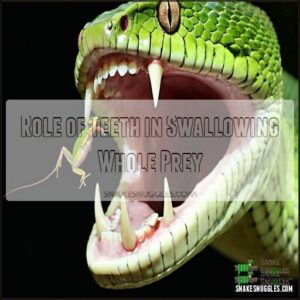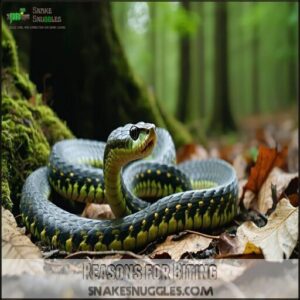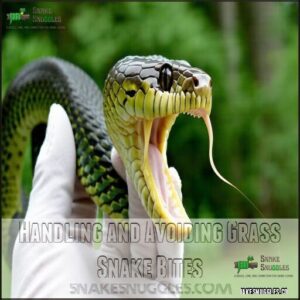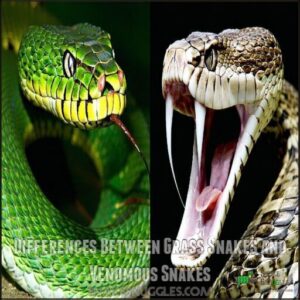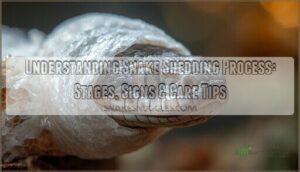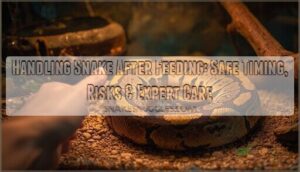This site is supported by our readers. We may earn a commission, at no cost to you, if you purchase through links.
 Yes, grass snakes do have teeth! You’ll find these small, recurved teeth arranged in two rows on their upper jaw and one row on their lower jaw.
Yes, grass snakes do have teeth! You’ll find these small, recurved teeth arranged in two rows on their upper jaw and one row on their lower jaw.
Unlike their venomous cousins, grass snakes don’t have fangs for delivering venom. Instead, their teeth work like tiny fish hooks, helping them grip slippery prey like frogs and small fish.
While they might nip if threatened, their bite isn’t dangerous to humans – just a pinch that rarely breaks skin. Think of them as nature’s dental marvels, perfectly designed for their amphibian-heavy diet.
The way these harmless garden visitors use their teeth actually reveals fascinating survival strategies.
Table Of Contents
- Key Takeaways
- Grass Snake Teeth: an Overview
- Grass Snake Feeding Behavior and Dentition
- Grass Snake Bite and Defensive Behaviors
- Differences Between Grass Snakes and Venomous Snakes
- Grass Snake Conservation and Coexistence With Humans
- Frequently Asked Questions (FAQs)
- Do snakes have teeth?
- Do grass snakes have teeth?
- Why do grass snakes have two rows of teeth?
- Why do grass snakes have recurved teeth?
- Do grass snakes bite?
- Do snakes have aglyphous teeth?
- What Are the Colors of a Grass Snake?
- Are Grass Snakes Poisonous?
- How Do I Identify a Grass Snake?
- Where Do Grass Snakes Live?
- Conclusion
Key Takeaways
- Grass snakes have three rows of small, curved teeth (two on top, one on bottom) that function like tiny fishhooks to grip slippery prey like frogs and fish, not to deliver venom.
- You’ll find their teeth continuously regenerate throughout their lives, with fresh teeth developing beneath the gums while old ones dissolve – a natural replacement system that keeps their bite effective.
- Their teeth rarely pose danger to humans as grass snakes prefer defensive tactics like releasing foul-smelling musk or playing dead rather than biting when threatened.
- You’re supporting important ecological workers when you protect grass snakes, as they help control pest populations in gardens and maintain balanced ecosystems across wetlands and terrestrial habitats.
Grass Snake Teeth: an Overview
You’ll find that grass snakes have three rows of small, curved teeth that work like tiny fishhooks to grip their slippery meals.
These teeth are constantly regenerating and allow the snake to unhinge its jaw, helping it swallow prey whole without needing a single dental checkup, which is a remarkable example of biological adaptation.
Dental Anatomy of Grass Snakes
Grass snakes possess a fascinating dental structure that might surprise you when examined up close.
Unlike our teeth, these reptiles have a unique dental anatomy designed specifically for their survival needs.
The dental anatomy of grass snakes includes:
- Three rows of small, curved teeth – two on top and one on the bottom
- Backward-curved teeth that function like tiny fishhooks to grip prey
- A continuous tooth regeneration system that keeps their bite effective
While small in size, grass snake teeth are perfectly adapted for their hunting style.
Their jaw mechanics allow them to unhinge, enabling them to swallow prey whole despite their narrow heads.
This remarkable snake dentition requires no dental care, as fresh teeth naturally emerge while old ones dissolve away.
As aglyphous snake teeth lack venom grooves, grass snakes rely on constriction and swallowing.
The tooth shape – small, curved, and numerous – creates an efficient gripping system for capturing slippery meals.
Types of Teeth in Grass Snakes
These slithery creatures pack quite the dental arsenal! When examining grass snake teeth, you’ll discover a fascinating arrangement – two rows on top and one on the bottom.
This unique dental structure serves their hunting needs perfectly, featuring small, curved teeth that function like tiny hooks, gripping prey efficiently.
| Feature | Function |
|---|---|
| Backward Curve | Grips prey securely |
| Small Size | Perfect for quick strikes |
| Multiple Rows | Increases holding power |
| Sharp Tips | Aids in catching fish |
| Flexible Spacing | Allows for various prey sizes |
Think of their teeth as nature’s fishhooks – they’re not venomous fangs but specialized tools designed for catching slippery meals.
This evolutionary adaptation helps these semi-aquatic colubrids thrive as primarily amphibian eaters. Their snake teeth anatomy is perfectly suited for grabbing frogs, toads, and fish while ensuring dinner doesn’t escape, making them highly efficient predators.
Tooth Replacement and Shedding
Nature has blessed grass snakes with a dental plan humans could only dream about! Unlike us, these reptiles enjoy continuous tooth replacement throughout their lives.
When you examine snake dentition closely, you’ll discover their impressive regeneration system:
- Fresh teeth develop beneath the gums while old ones are still in use
- Tooth replacement occurs every few months, depending on dietary impact
- The shedding process happens internally – old teeth dissolve from within
- Shedding frequency increases during active feeding periods
- Shedding problems are rare, but can occur with poor nutrition
This remarkable system guarantees grass snake teeth always remain sharp and functional. As one tooth wears down, another is ready to take its place. The replacement process happens seamlessly, without disrupting the snake’s feeding habits. It’s like having a lifetime warranty on their dental equipment – no appointments or drills required!
Grass Snake Feeding Behavior and Dentition
You’ll be amazed how grass snakes use their three rows of small, curved teeth to grip slippery prey like fish and frogs before swallowing them whole.
Their special jaw can unhinge to accommodate larger meals, while those tiny backward-curving teeth work like nature’s fishhooks to keep dinner from escaping, utilizing their unique dental structure to ensure a successful hunt with nature’s tools.
Capturing and Consuming Prey
How do grass snakes actually capture their meals in the wild? Their hunting success relies on specialized teeth and precise tactics.
When observing grass snake feeding habits, you’ll notice three distinct phases:
- Silent stalking – they patiently track prey using heat-sensing abilities
- Lightning-quick striking – their snake teeth grip slippery prey like tiny fishhooks
- Firm holding – backward-curved teeth prevent escape while the snake maneuvers its meal
Prey size varies widely, from small frogs to larger fish, all captured with remarkable efficiency.
Role of Teeth in Swallowing Whole Prey
Have you ever wondered how a snake swallows prey much larger than its head? The secret lies in their specialized teeth.
Building on how grass snakes capture prey, their small, backward-curved teeth work like tiny fishhooks during the swallowing process. Snakes exhibit polyphyodont tooth replacement, ensuring a continuous supply of functional teeth.
| Feature | Function | Benefit |
|---|---|---|
| Backward curve | Prevents prey escape | One-way grip |
| Multiple rows | Enhances control | Better hold |
| Small size | Reduces resistance | Smoother swallowing |
These teeth don’t chew but instead grip and guide food down their throat. Combined with their amazing jaw flexibility, this dental design creates nature’s perfect "no return" system for slippery meals, allowing snakes to efficiently consume their prey with a one-way grip and better hold.
Adaptations for Omnivorous Diet
While teeth help grass snakes swallow prey whole, their dental structure truly shines when adapting to their varied diet.
Though not strictly omnivorous, grass snakes have remarkable feeding adaptations:
- Their recurved teeth grip slippery amphibians like frogs
- Poisonous saliva helps stun prey before consumption
- Solid, conical teeth handle different prey sizes efficiently
- Teeth and jaws work sideways to manage larger meals
These adaptations let grass snakes thrive in diverse habitats while maintaining their primarily amphibian-based diet.
Grass Snake Bite and Defensive Behaviors
You’ll rarely face a grass snake bite, but when you do, it’s more startling than harmful since they use their small curved teeth only as a last resort.
When threatened, these timid creatures prefer to release a foul-smelling musk or play dead rather than confront you directly, making them masters of the reptile world’s bluff tactics.
Reasons for Biting
While we’ve seen how grass snakes use their teeth for feeding, they rarely use them against humans.
Grass snakes only use their tiny teeth for dinner, not for defense—they’d rather flee than fight!
Defensive biting occurs only when these shy reptiles feel genuinely threatened. You’ll typically see this fear response when they’re cornered with no escape route, picked up unexpectedly, or handled roughly.
Sometimes, cases of mistaken identity occur – they might bite if they confuse your finger for food! Handling stress is a major provocation factor; even the gentlest grass snake has its limits.
Remember, these non-venomous creatures would much rather slither away than confront you. Their bite is simply their last-resort way of saying, "Please leave me alone" and they use it to defend themselves when they feel genuinely threatened.
Bite Force and Effectiveness
While grass snakes don’t have venom, their bite mechanics are surprisingly effective.
These shy creatures possess bite strength that’s perfectly suited for their hunting needs.
Their bite force and jaw mechanics work together to create an efficient system:
- Hook and Hold: Small, curved teeth act like tiny fishhooks that grip slippery prey
- Quick Strike: Lightning-fast bites prevent prey escape before teeth secure their meal
- Minimal Damage: Grass snake bites rarely cause serious bite wounds to humans
- Defense Impact: More startling than harmful, their bites are primarily a last-resort defense
The effectiveness of grass snake teeth isn’t in power but in their specialized design.
When threatened, they’ll usually flee rather than bite—making an encounter with their dental arsenal quite rare.
Grass snakes require specific temperature ranges to thrive in captivity.
Handling and Avoiding Grass Snake Bites
While a grass snake’s bite doesn’t pack much punch, prevention is always better than treatment. When handling these non-venomous snakes, remember they’re timid creatures who bite only when threatened.
| Safe Handling Tips | Bite Prevention | First Aid |
|---|---|---|
| Support body fully | Limit handling frequency | Wash with soap and water |
| Move slowly and calmly | Wear thin gloves | Monitor for infection |
| Never grab from above | Keep children supervised | No medical attention needed |
If bitten, don’t panic! Their small, harmless teeth might scratch but won’t cause serious injury. For added protection, consider using specialized handling equipment. Simply clean the area thoroughly – no venom means no emergency.
This approach ensures safe handling and minimizes the risk of a bite, making it a crucial part of interacting with grass snakes.
Differences Between Grass Snakes and Venomous Snakes
You’ll quickly notice that grass snakes have small curved teeth arranged in rows.
Unlike their dangerous cousins, our friendly garden grass snakes use their tiny teeth just to grip slippery prey, not to deliver toxic substances.
You’ll also observe that, unlike their venomous counterparts, venomous snakes have specialized hollow fangs for injecting venom.
Identifying Venomous Snake Fangs
When comparing snake mouths, the difference between venomous fangs and non-venomous teeth is striking.
Unlike the simple teeth of grass snakes, venomous snakes have specialized fangs for venom delivery.
- Hollow Design: Venomous snake fangs function like tiny hypodermic needles, with internal channels for venom transfer
- Position Matters: Pit vipers have front-positioned fangs while rear-fanged snakes keep their venom tools toward the back
- Visual Differences: Snake fangs vs teeth are distinguishable by length and shape – fangs are markedly longer and curved
Snake teeth identification helps guarantee safety during outdoor activities.
Coral snakes, for instance, have small fixed fangs, while grass snake teeth remain small and uniform throughout.
Nonvenomous Nature of Grass Snakes
Unlike their venomous cousins, grass snakes possess no dangerous fangs or venom.
Gentle garden companions with tiny teeth, grass snakes hunt with hook-like grips rather than venomous strikes.
These harmless snakes have small, curved teeth designed purely for gripping slippery prey like frogs and fish—not for defense against humans.
During safe encounters, you’ll notice their timid behavior; they prefer fleeing to fighting.
If threatened, they rely on clever tricks like releasing foul-smelling musk or playing dead rather than biting.
Their mild bites rarely break skin.
Importance of Proper Snake Identification
Safety begins with knowing one snake from another, especially in the case of those with teeth versus fangs.
Proper identification helps you:
- Avoid species misidentification – grass snakes have small, backward-curved teeth, not venomous fangs
- Contribute to conservation concerns – protecting harmless species supports habitat preservation
- Know what to do for first aid – non-venomous snake bites need different treatment than venomous ones
- Maintain public safety – educating others prevents unnecessary snake killings
You can spot a grass snake by its distinctive yellow collar and round pupils. Unlike their dangerous cousins, these non-venomous snakes have multiple rows of tiny teeth designed just for gripping slippery meals, not injecting venom. Accurate identification requires understanding key features.
Remember: most snakes you’ll encounter are just as scared of you as you might be of them, and proper identification is key to public safety and conservation concerns.
Grass Snake Conservation and Coexistence With Humans
You’ll find that these shy garden visitors with their tiny teeth play a pivotal role in controlling pest populations, making them helpful neighbors rather than threats.
By understanding their habits and creating snake-friendly spaces in your yard, you can peacefully coexist with these beneficial reptiles that help maintain the natural balance of your local ecosystem.
Beneficial Ecological Role of Grass Snakes
The ecological role of grass snakes extends far beyond their modest appearance in our backyards and wild spaces.
These remarkable reptiles serve as nature’s own pest control system, with their diet consisting primarily of amphibians, small mammals, and occasionally fish.
You’ll find they’re particularly fond of frogs and toads, helping maintain balanced populations without the need for chemical interventions.
When grass snakes appear in your garden or local wetlands, they’re actually signaling a healthy ecosystem.
As indicator species, their presence suggests biodiversity support throughout the food web.
They silently manage rodent populations that might otherwise damage your garden, connect aquatic and terrestrial ecosystems, strengthening wildlife protection, and contribute to wetland conservation by keeping amphibian numbers in check.
- They silently manage rodent populations that might otherwise damage your garden
- They connect aquatic and terrestrial ecosystems, strengthening wildlife protection
- They contribute to wetland conservation by keeping amphibian numbers in check
- They serve as middle-level predators, maintaining ecosystem balance between prey and apex predators
Next time you spot a grass snake, remember – you’re witnessing an important ecological worker in action!
Protecting Grass Snake Habitats
Building on the ecological benefits these reptiles provide, protecting grass snake habitats has become increasingly urgent due to habitat loss and climate change impacts.
Grass snakes thrive in diverse environments, but wetland conservation remains your top priority if you’re supporting these toothy creatures. These water-loving snakes depend on healthy pond edges, marshes, and damp meadows for hunting and reproduction. Native grasslands are also essential for their survival, offering essential shelter and food.
You can help by:
| Action | Impact |
|---|---|
| Maintaining garden ponds | Creates hunting grounds |
| Leaving log/compost piles | Provides egg-laying sites |
| Reducing pollution | Protects food sources |
Wildlife conservation efforts should include creating corridors between fragmented habitats, allowing snakes to move safely between areas. Remember, when you protect wetlands from development and pollution impact, you’re not just saving grass snakes—you’re preserving entire ecosystems that depend on these important predators.
Educating The Public on Grass Snake Behaviors
Educating people about grass snake behaviors is key to overcoming common snake misconceptions. When you understand these non-venomous creatures, you’ll appreciate their ecological importance and be less fearful.
- Grass snakes have small, backward-curving teeth for gripping prey, not for attacking humans—they’d rather slither away than bite!
- Learning safe handling techniques protects both you and the snake (though it’s best to observe from a distance).
- Their distinctive yellow collar makes grass snakes easy to identify, helping you distinguish them from other species.
- These timid reptiles play a vital role in controlling amphibian populations—they’re nature’s pest managers!
Proper grass snake supplies aid responsible care. Responsible observation and habitat preservation guarantee these helpful reptiles continue to thrive alongside us.
Frequently Asked Questions (FAQs)
Do snakes have teeth?
Yes, snakes do have teeth.
They’re small, curved backward like tiny fishhooks, and designed to grip prey rather than chew.
Most snakes have multiple rows that continuously regenerate throughout their lives.
Do grass snakes have teeth?
Grass snakes definitely have teeth – three rows of small, curved ones that work like tiny fishhooks.
Two rows sit on top and one on the bottom, perfect for gripping slippery prey.
Why do grass snakes have two rows of teeth?
The double-row tooth structure helps snakes securely grip slippery prey like fish and amphibians.
Your snake’s top teeth work like tiny fishhooks, while the bottom row guides food down its throat during swallowing.
Why do grass snakes have recurved teeth?
Recurved teeth in grass snakes act like tiny fishhooks, gripping slippery prey as they swallow it whole.
You’ll notice these backward-curved teeth help them securely hold onto frogs and fish during feeding.
Do grass snakes bite?
While generally timid, grass snakes can bite if they feel threatened.
You’ll likely experience their other defenses first – like musking with foul-smelling secretions or playing dead – before they’d resort to biting.
Do snakes have aglyphous teeth?
Yes, some snakes do have aglyphous teeth. These are solid, non-grooved teeth that don’t connect to venom glands. You’ll find them in non-venomous species like grass snakes and rat snakes.
What Are the Colors of a Grass Snake?
Grass snakes typically sport olive-green or brown bodies with distinctive black markings.
You’ll notice their famous yellow and black collar behind the head, while their bellies are lighter with dark blotches.
Are Grass Snakes Poisonous?
While they can bite with their small, curved teeth, you’re safe from venom with grass snakes.
They’re non-poisonous and rely on foul-smelling secretions and playing dead when threatened instead of toxic bites.
How Do I Identify a Grass Snake?
Look for a dark green or brown snake with a distinctive yellow or white collar behind the head.
You’ll notice black markings along its back and a light-colored belly with irregular black blotches.
Where Do Grass Snakes Live?
You’ll find grass snakes in wet habitats near bodies of water, open woodlands, and field borders.
They’re common in Great Britain and throughout Europe, from mid-Scandinavia to southern Italy and parts of Africa.
Conclusion
Ultimately, now you know the truth about grass snake teeth—small but mighty tools perfectly adapted for catching slippery prey.
Ever wondered why these garden friends rarely pose any threat to humans? Unlike venomous species, grass snakes use their teeth simply to grip, not to deliver venom.
They’re remarkable examples of evolution’s precision engineering, helping these beneficial reptiles thrive in our ecosystems.
So next time you spot one in your garden, remember: do grass snakes have teeth? Yes, but they’re nothing to fear!



